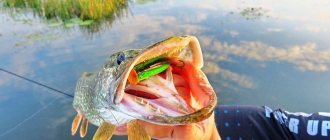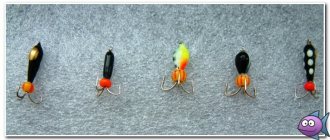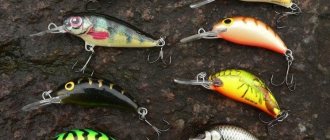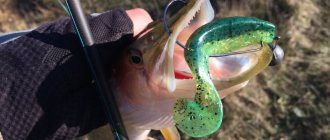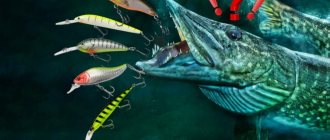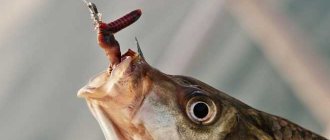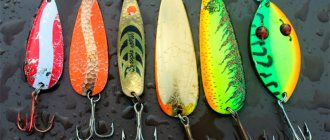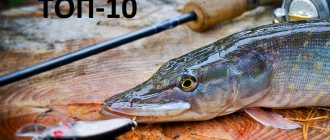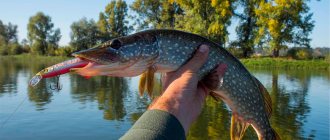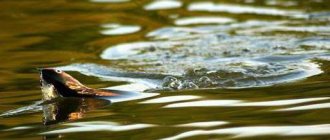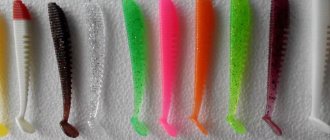Bait selection
A distinctive feature of the twister for pike fishing is the large size of the “rubber”. Twisters for catching pike-perch and perch can only attract small pike. In order to organize a hunt for a trophy toothy predator, baits with a length of at least 15 cm are purchased. The tail part must be wide so that the bait, when retrieved, produces vibrations that are attractive to predatory fish.
It is almost impossible to predict what color twister the pike will be interested in today.
This predator can change its “mood” several times during the day. Therefore, experienced fishermen stock up on different colors. This collection must include silver and gold colors, which are very rarely ignored by the toothy predator.
It’s also not worth spending too much time searching for a suitable aroma for fishing. This predator is not so “olfactory” that it can choose its prey by smell. You can successfully catch pike with both scented baits and odorless twisters; the main thing is to decide on the location so that the silicone fish ends up in the right place and at the right time.
Some pike fishermen claim that this predator becomes significantly more active if attractants with the aroma of smelt are used for fishing, but most likely, this pleasant cucumber aroma is more liked by the fishermen themselves than by the objects of their hunt.
Installation rules
attaching a twister to a jig head
Pike can be caught well with a twister only if all the conditions for selecting bait parameters are met.
The rules for installing a silicone product in this case also occupy a worthy place among the conditions that allow you to effectively fish with a twister.
The most popular types of installation are the following:
- Fishing with jig heads.
- Free installation on a hook.
- Mounting on offset hook.
Jig heads are selected in such a way that, despite all sorts of factors that contribute to the bait hanging in the water column, the “elastic band” quickly sinks to the bottom of the reservoir. If fishing for a predator is carried out on a river with a strong current, then a jig head is selected weighing at least 25 g. In the case when pike hunting is carried out in reservoirs where there is no current, you can choose jig head models with a lighter weight.
For free installation of a rubber fish, a hook is used with a long shank. This is necessary in order to remove the hook tip from the bait as far as possible. The ideal option is to place the sting near the tail section.
placing a twister on a hook
When hunting for pike, lures of quite long length are used, so the “elastic band” is pierced with a hook at the base and brought out in the middle part.
Very good results can be obtained when catching this toothy predator if you use a double hook for free installation. In this case, installation is carried out in the reverse order. The “elastic band” is pierced by the forend of the double in the middle part and brought out as close as possible to the base, then the fishing line is tied, and further equipment is carried out.
The use of non-hooking elements is practically no different from free installation. To do this, the offset hook is installed, as with standard free installation.
Shape of pike vibrotail
The pike vibrator looks like a fry with a short hoof-shaped tail.
Vibrotails are distinguished by the shape of their body and tail. Based on body shape, vibrotails are classified into:
- shads. This is a bait with a thickening in the middle part and a compact tail, reminiscent of a herring. The slight heaviness and clumsiness of such a “fat man” are characteristic of fish that live in reservoirs with stagnant water. They are the main food for catfish. Therefore, it is shad that will be effective when hunting for pike in holes and in water areas without a current. It is believed that shad are indispensable for catching trophy pike;
- longs (“long”). Elongated, oblong lures with a thin tail are designed for fishing in currents. Externally they look like bleak. Posting a ripper in such conditions is accompanied by resistance to the current, while it, like a living fish, sharply wags its body. This behavior is typical of a fry that has lagged behind the flock, which will certainly provoke the predator to attack. Narrow baits have better aerodynamic properties: they fly further and more accurately.
If there is an urgent need, a wide vibrating tail can always be turned into a narrow one by trimming the belly.
The appearance of pike vibrotails is less elegant compared to pike perch and perch rubber. They are more massive and voluminous.
The nature of the vibrating tail's play directly depends on the design features of the tail blade. According to this parameter, rippers are divided into:
- narrow-tailed rippers. Due to the low resistance to the oncoming flow of water, the tail section vibrates with high intensity. Such a ripper in motion imitates the behavior of a fussy fry;
- broad-tailed rippers. The large surface of the tail provides significant resistance to water flows, as a result of which the vibrotail plays leisurely, reminiscent of a clumsy toothed fish.
All kinds of improvements to the tail, such as notches and slits, significantly improve the dynamics of the game of the vibrotail, luring the passive predator out of its parking areas.
In addition, the success of fishing depends on the quality of the bait. You can evaluate the quality by holding it by the head, lifting it up with its tail and shaking it a little. A high-quality vibrating tail will oscillate in different directions with the same amplitude. The game of such a ripper will be stable even at low wiring speeds. The softness level of the bait is checked by swinging it by the tail.
Catching models
Not every colored piece of rubber thrown into the water can attract predatory fish. In order for the bait to play correctly, it must be given a streamlined shape, and the tail must produce vibrations when moving that attract a predator.
Healthy competition in this market forces manufacturers of silicone products to develop more advanced models.
The most interesting twisters for pike fishing today are the following models:
SAVAGE GEAR Monster Slug 20
This 20cm twister from the Danish company “SAVAGE GEAR” is designed for catching predatory sea fish. Can also be used for catching large predators in fresh water. Trophy-sized pike will definitely be interested in this unusual “tailwinder”.
Sold at a price of 800 rubles.
FSM-110-001 domestic company “FREEWAY”
Excellent for pike fishing. The length is 11 cm, which allows you to catch both trophy predators and medium-sized pike. Twister is one of the most inexpensive in its class.
The price for a package containing 3 such baits is only 200 rubles.
MANN`S TWISTER 040 CH
Classic soft bait for pike fishing. The twister is made of a material that can be used at low water temperatures, while the properties of the bait do not change even in the harsh conditions of winter fishing.
Cost 1 piece. approximately 50 rubles.
Pontoon 21 Homunculures Hightailer
Ideal for catching pike in small ponds overgrown with aquatic vegetation. The length of the bait is 82 mm, which allows you to catch toothy predators of different weight categories.
The package can be purchased for 200 rubles.
Mann s (M-013) JB
This unusual purple twister is to the taste of the toothy predator. The length is 12.5 cm, which is suitable for catching medium to large fish.
Packaging price – 280 rubles.
What is twister
Twister is an artificial bait for fishing on a spinning rod, made of silicone. It consists of an elongated body and a long tail , which plays during wiring.
Unlike a vibrotail or a wobbler, the twister’s appearance does not resemble any of the usual food items for pike. But this does not prevent him from attracting a toothy predator and tempting her to bite.
When choosing an object to attack, the pike orients itself primarily thanks to its lateral line, which perceives movement in the water. During wiring, the twister vibrations in the water that attract the predator.
Fishing tackle
- The first thing a pike fishing tool needs is a steel leader. Without this accessory, the fishing line will be rubbed by sharp pike teeth. You can buy a special leash in the store or make it yourself from a guitar string, but in any case, the fish will not bite through the metal, and the catchy twister will be preserved, even if the fish comes off the hook.
- The rod for fishing from the shore is chosen to be at least 3 meters long. If fishing is carried out from a boat, then the form may be shorter. Rods with an ultra-light test are chosen when fishing will be done with bait without a sinker, only a hook and a twister. When fishing with heavy jig heads, the rod test should be in the range of 20 - 50 g.
- The reel must be powerful, inertia-free, with a large spool, on which up to 100 meters of fishing line with a diameter of 0.5 mm can be wound.
- The fishing line is chosen to be strong enough. If the hunt is for a trophy predator, then a cord with a diameter of at least 0.4 mm is selected.
- Hooks must be of high quality stainless steel , even if the tip of the hook extends beyond the bait, the additional shine of the metal is not superfluous when catching predatory fish.
Vibrating tail color for pike
Despite the ambiguity of judgments about the importance of the color of silicone baits on the fishing result, when choosing the color of a pike ripper, it is better to adhere to certain time-tested rules.
Depending on the:
- time of year. In autumn and spring, it is better to choose edibles in natural colors; blue color with its shades also works well. Exotic colors such as carrot, light green and bright yellow are better suited for fishing in hot weather;
- pike activity. If the predator is active and constantly attacks the bait, then natural colors are more effective. For sluggish and passive pike, it is recommended to use irritating and provoking vibrating tails, such as bright or acidic ones;
- depths. Colors visible in sunlight become almost indistinguishable at depth. First of all, this applies to silicone in white and yellow colors. And colors such as acidic, light green and combined red and white, on the contrary, are visible more clearly. In shallow water, vibrating tails interspersed with sparkles are effective. In bright weather, dark lures with a reflective effect in the form of sparkles are especially successful when fishing for pike. At medium depths (2-3 meters), red rippers have proven themselves to be excellent;
- water transparency. For muddy water, it is better to take bright and light-colored baits, as they are easier to notice. If the water is clear, then you should give preference to dark vibrotails.
The universal working colors for pike are pearlescent with a black or blue back, as well as the color “machine oil”. The glitter on the bait helps to lure a predator from afar with its sparkle.
Time and place
For high catches of any type of fish, it is necessary to know the time of greatest activity, when the fish feed almost throughout the day, and sometimes even at night. The zhor of predatory fish is especially strong at the end of spawning. For pike, this period begins in spring in April. There is a popular belief that during the rose hips flowering, pike are caught especially actively.
If this moment is not missed, then the fisherman will be provided with a large catch of the toothy predator, which at this time rushes to the twister as soon as the bait is in the water.
In autumn, pike also actively feed before the difficult winter months. During this period, the predator can be successfully caught using natural or artificial silicone baits.
If you don’t have a goal to catch a huge pike, then for fishing you can sit in shallow water and catch the predator on the border with aquatic vegetation. Such places are inhabited by grass pike, whose weight rarely exceeds 3 kg. Fishing in such reservoirs can be even more successful than in deep-sea holes. At the same time, the catch will be greater due to the number of predators caught.
Vibrating tail size for pike
For pike, vibrating tails ranging in size from 5 to 20 cm are used, but usually their length varies in the range of 8-13 cm. It is better not to attach baits smaller than 5 cm to a catfish, since perch can interfere with pike hunting, and pike fish are not averse to profiting tiny silicone.
There is an opinion that the activity of the fish determines the choice of bait size. The more passive the pike, the shorter the vibrotail should be. The minimum activity of pike occurs in the summer heat. At this time, the fish's metabolism is slow and there is no need to hunt for large prey. In addition, juvenile fish, which are the main food for the spotted beauty, have not yet grown to the required size.
We suggest you read: Which echo sounder is better to choose for fishing
By autumn, the fry grow up, and the pike reacts with great desire to large vibrating tails. If in summer the minimum ripper size was 50 mm, then in autumn it was 75 mm. At the same time, a hungry predator can grab a truly huge rubber. It is not uncommon for a pike to attack a bait two-thirds of its length.
How to catch?
The technique of fishing for pike with a twister depends on the equipment used:
- To catch a predator on a jig head, step-by-step wiring is carried out. To do this, the twister is thrown to a place where a predator may be. First of all, you need to pause, after the jig head touches the bottom, make several turns of the reel, followed by a pause of several seconds. Thus, when reeling in the fishing line, the elastic band rises up, and during a pause it quickly sinks to the bottom, vibrating its tail part attractively for the predator. Bites often occur precisely at the moment when the twister goes vertically to the bottom.
- If the twister is used without a sinker , then direct wiring is used, while the reel handle rotates very slowly.
- The pike's hunting strategy consists of ambush waiting for prey and, as soon as the slowly moving twister is in the field of view of this predator, a guaranteed pike bite will follow. There is no need to rush into hooking the prey; the predator first presses its prey firmly with its jaw, and then tries to turn its food around to swallow it; it is important not to snatch the bait from the pike at this moment.
- If fishing is carried out in ponds that are heavily overgrown with vegetation or snags , then snags and breaks in the gear are possible when retrieving. To prevent this from happening, an offset hook is used on which the twister is installed.
With this installation of gear, hooks are practically eliminated, but the pike can get off the hook without much difficulty.
Looking for big pike
The minimum size of pike allowed for catching is 35 cm. Such individuals are called “pencils” or “shurogags”. Predators are considered large, with body size starting from 1 m and weight starting from 7 kg. To reach this size, a pike needs to live 7-10 years.
Reference! The largest specimen in our country was caught in 1930 in the waters of Lake Ilmen (Novgorod region). The pike weighed 34 kg.
Fall is the perfect time to find big fish. Such individuals are selective in their habitat and feeding habitat. Trophy specimens are solitary: they do not live or feed with “pencils” or young fish.
We invite you to read: Fishing for Pike in Winter on the River
It is unlikely to encounter a large pike in shallow water. Such predators prefer deep-sea areas:
- deep holes at the bottom, whirlpools;
- channel channels on the river;
- places where tributaries flow;
- crevices and gorges at the bottom;
- deep creeks;
- sunken trees, snags.
There are high chances of catching a large pike in a large and deep area - a river, a reservoir, a lake. In small ponds or settling tanks (maximum depth no more than 3 m), it is difficult to catch a predator of decent size. There is a small food supply and a lack of places for shelter or hunting. The maximum possible weight of individuals is no more than 5 kg.
Blitz tips
- When fishing, after just a few bites , you have to change the bait because the rubber “doesn’t want” to stay on the hook. To solve this problem, just apply a drop of super glue to the base of the twister, between the hook and the rubber, and let it sit for a couple of minutes. After such “repairs”, the rubber bait can still be used for a long time.
- If a fish has swallowed a twister deeply , then in order to safely remove the hook, the toothy pike mouth is held in an open position using a special device called a gaper. Without this device, you should not go hunting for this toothy “beast”.
- Twister is the cheapest bait , so it is better to start mastering pike hunting with a rubber fish. When the basics are mastered, you can move on to the “heavy artillery” of wobblers and spinners.
